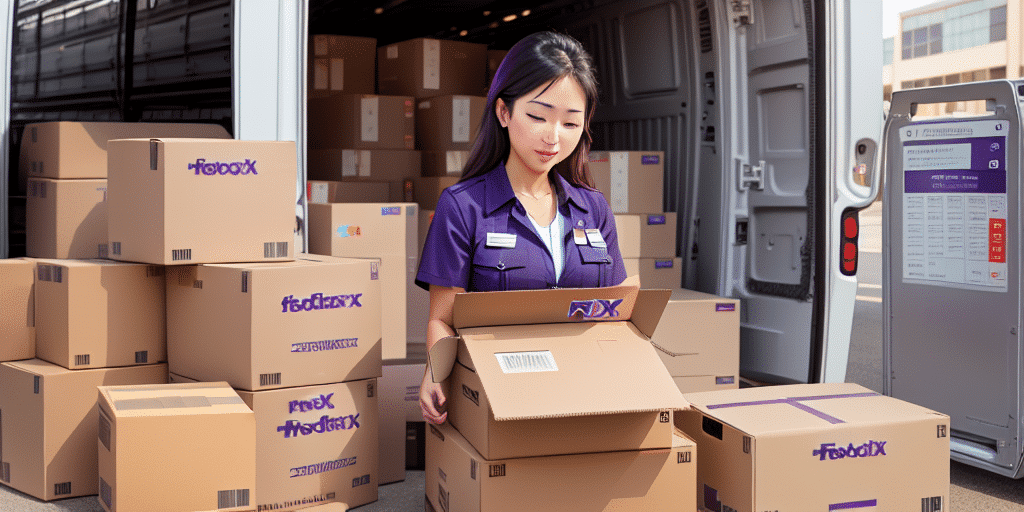How to Connect, Optimize, and Manage FedEx for SPS Commerce Fulfillment
As a leading logistics provider, FedEx offers numerous benefits for companies aiming to streamline their fulfillment processes. By integrating FedEx with SPS Commerce, businesses can achieve enhanced efficiency and significant cost savings. In this comprehensive guide, we explore why FedEx is an optimal choice for SPS Commerce fulfillment, provide a step-by-step walkthrough for connecting, optimizing, and managing this integration, discuss common challenges and best practices, and highlight successful case studies. Let’s dive in!
Why FedEx is an Ideal Choice for SPS Commerce Fulfillment
One of the primary advantages of using FedEx for fulfillment is its expansive network of distribution centers and diverse transportation options. Serving over 220 countries and territories, FedEx can cater to virtually any business's shipping needs. Moreover, FedEx offers a variety of shipping speeds and services, from overnight delivery to freight services, ensuring flexibility and reliability.
According to FedEx’s annual reports, the company consistently ranks high in reliability and customer satisfaction, which is crucial for maintaining a positive reputation and fostering repeat business. When integrated with SPS Commerce's robust platform, FedEx enhances the overall fulfillment solution for e-commerce enterprises.
Furthermore, FedEx provides advanced technology and tracking capabilities. For instance, FedEx’s Ship Manager® software offers real-time tracking and visibility of shipments, enabling businesses to monitor their inventory and ensure timely delivery to customers. This transparency is vital for maintaining customer satisfaction and loyalty.
Additionally, FedEx's commitment to sustainability, such as their Carbon Neutral® program, offers eco-friendly shipping options. This aligns with the values of many modern consumers who prioritize environmental responsibility, allowing businesses to demonstrate their commitment to sustainability.
The Benefits of Integrating FedEx with SPS Commerce
Integrating FedEx with SPS Commerce allows businesses to leverage the strengths of both systems, achieving greater speed, accuracy, and cost savings. SPS Commerce provides a cloud-based platform that connects companies to all their trading partners, including suppliers, retailers, and third-party logistics providers. With real-time inventory and shipping data, and automated order processing, SPS Commerce helps reduce errors and delays, increase order accuracy, and lower operational costs.
One significant benefit of this integration is the ability to track shipments in real time. This feature allows businesses to monitor the progress of their shipments and make necessary adjustments to ensure timely delivery. Moreover, SPS Commerce's platform offers visibility into inventory levels across all trading partners, enabling better supply chain management and reducing the risk of stockouts.
Another advantage is the streamlined billing process. SPS Commerce's platform automatically generates invoices based on shipping data, minimizing manual data entry and reducing errors. This automation not only saves time and money but also improves accuracy and minimizes the risk of disputes with trading partners.
Step-by-Step Guide to Connecting FedEx with SPS Commerce
Connecting FedEx with SPS Commerce is a straightforward process that can be accomplished in a few simple steps:
- Create an SPS Commerce account and select FedEx as your carrier.
- Enter your FedEx account information and establish shipping preferences.
- Integrate SPS Commerce with your existing fulfillment system or use SPS Commerce's integrated fulfillment solution.
- Start processing orders and shipments using the combined FedEx and SPS Commerce platform.
By connecting FedEx with SPS Commerce, you can streamline your shipping process and improve your overall efficiency. With this integration, you can easily manage your orders and shipments in one place, reducing the risk of errors and delays. Additionally, you can take advantage of FedEx's extensive network and shipping options, ensuring that your packages are delivered quickly and reliably. Whether you're a small business or a large enterprise, connecting FedEx with SPS Commerce can help you save time and money while enhancing your customer experience.
Tips for Optimizing FedEx and SPS Commerce Integration for Fulfillment Success
To maximize the benefits of your FedEx and SPS Commerce integration, it's essential to optimize your processes and workflows. Here are some tips to help you enhance your fulfillment efficiency and accuracy:
- Automate Order Processing: Set up automated order processing and shipment notifications to reduce manual data entry and minimize errors.
- Leverage Real-Time Data: Use real-time inventory and shipping data to make informed decisions about fulfillment strategies and product availability.
- Analyze Shipping Data: Regularly review and analyze shipping data to identify areas where costs can be reduced and service levels improved.
- Customize Reports and Alerts: Create customized reports and alerts to monitor key metrics and identify potential issues promptly.
Another crucial tip is to ensure that your product data is accurate and up-to-date, including descriptions, dimensions, and weights. Accurate product data helps ensure that shipments are properly classified, preventing overpayment for shipping and enhancing delivery accuracy.
Additionally, understanding your shipping options and rates is vital. Research and compare different shipping services and rates to find the best options for your business. This can help you save on shipping costs and improve your overall fulfillment efficiency.
How to Effectively Manage Your FedEx and SPS Commerce Integration
Managing your FedEx and SPS Commerce integration requires a proactive approach to monitoring and problem-solving. Here are some best practices for effective management:
- Assign Dedicated Personnel: Designate staff or a team to manage the integration and monitor its performance.
- Establish Communication Channels: Set up clear communication channels with FedEx and SPS Commerce support teams to quickly resolve any issues.
- Regularly Update Settings: Continuously review and update your shipping policies, preferences, and account settings to align with business goals and customer needs.
- Conduct Audits and Testing: Perform regular audits and testing to ensure the integration functions correctly and address any emerging issues.
Staying informed about any changes or updates to FedEx and SPS Commerce systems is also essential. This includes new features, updates to shipping rates, or changes to APIs. By keeping up-to-date, you can ensure that your integration leverages the latest technologies and enhancements.
Additionally, regularly analyzing your shipping data to identify trends in shipping times, costs, and delivery rates can help you make informed decisions about optimizing your shipping processes and improving customer satisfaction.
Common Challenges with FedEx and SPS Commerce Integration and How to Overcome Them
Like any integration, implementing and using the combined FedEx and SPS Commerce solution may present challenges. Here are some common issues and strategies to overcome them:
- Integration Errors or Delays: Regularly test and troubleshoot the integration, and utilize support resources to resolve issues promptly.
- Limited Shipping Options or Customization: Collaborate with FedEx and SPS Commerce to understand available options and determine the best approach for your business needs.
- Cost Management: Continuously evaluate shipping costs and explore opportunities for negotiation or optimization to manage expenses effectively.
- Training and Adoption: Provide comprehensive training and ongoing support to staff to ensure they are proficient with the integration and can use it effectively.
Another challenge businesses may face is potential data discrepancies or errors. It's crucial to regularly monitor and reconcile data between FedEx and SPS Commerce systems to ensure accuracy and prevent issues. Establishing clear communication channels between your business, FedEx, and SPS Commerce can facilitate the quick resolution of any discrepancies or errors that arise.
Best Practices for Using FedEx with SPS Commerce Fulfillment
Implementing best practices can significantly enhance the effectiveness of using FedEx with SPS Commerce. Consider the following strategies:
- Utilize Shipping and Tracking Data: Leverage the shipping and tracking data provided by FedEx and SPS Commerce to improve customer service and order accuracy.
- Regularly Update Shipping Policies: Continuously review and update your shipping policies and preferences to adapt to changing business needs and market trends.
- Engage with Support Resources: Utilize available resources and support channels, such as online forums or training materials, to stay informed about updates and best practices.
- Collaborate with Trading Partners: Work closely with your trading partners and other stakeholders to ensure a seamless and efficient fulfillment process.
Additionally, consider the packaging of your products when using FedEx with SPS Commerce. Use appropriate packaging materials and methods to ensure the safe and secure delivery of your products, preventing damage during transit and reducing the likelihood of returns or customer complaints. Moreover, consider the environmental impact of your packaging choices and strive to use sustainable materials whenever possible.
The Future of eCommerce Fulfillment: How FedEx and SPS Commerce are Paving the Way
As the e-commerce landscape continues to evolve, FedEx and SPS Commerce are at the forefront of innovation to meet changing demands and challenges. Here are some trends and developments to watch for:
- Artificial Intelligence and Machine Learning: Increased use of AI and machine learning to enhance shipping and fulfillment processes.
- Greater Automation: Enhanced automation and integration of shipping, warehousing, and inventory management solutions.
- Expanding Global Reach: Broader global reach and improved cross-border shipping capabilities.
- Improved Sustainability: Advancements in sustainability and eco-friendly shipping and fulfillment practices.
One of the most significant challenges facing eCommerce fulfillment is the growing demand for same-day and next-day delivery. To meet this demand, FedEx and SPS Commerce are exploring innovative solutions like drone deliveries and autonomous vehicles to optimize their supply chains and delivery networks.
Another emerging trend is the rise of omnichannel fulfillment, which allows customers to order online and pick up their purchases in-store. FedEx and SPS Commerce are working to integrate eCommerce and brick-and-mortar operations, providing a seamless shopping experience for customers across multiple channels.
Case Studies: Successful Implementation of the FedEx and SPS Commerce Integration
To illustrate the effectiveness of integrating FedEx with SPS Commerce, here are some examples of companies that have achieved greater fulfillment efficiency and cost savings:
- XYZ Corporation: By integrating FedEx and SPS Commerce, XYZ Corporation reduced shipping errors by 75% and achieved a 20% reduction in fulfillment costs within six months.
- ABC Retail: ABC Retail utilized the combined FedEx and SPS Commerce platform to expand into new markets and reduce its international shipping costs by over 30%.
- 123 Distributors: Since implementing the integration, 123 Distributors has streamlined its fulfillment process and reduced time-to-ship by an average of 50%.
We hope this comprehensive guide has provided valuable insights and actionable tips for connecting, optimizing, and managing FedEx for SPS Commerce fulfillment. By leveraging the strengths of these two powerful systems, businesses can achieve greater efficiency, accuracy, and cost savings in their e-commerce operations. With continuous innovation and support from FedEx and SPS Commerce, the future of e-commerce fulfillment looks promising!






















